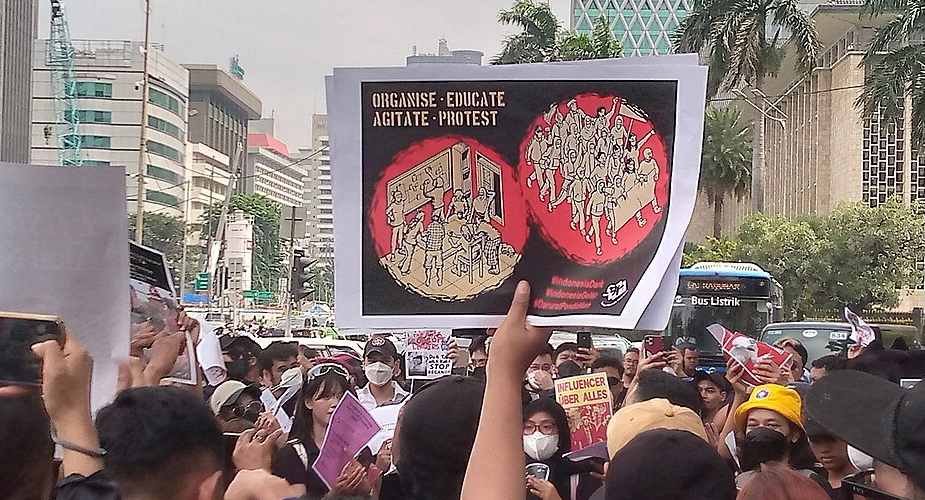Casual designs are not just revolutionising batik culture, they’re also giving batik workers new choices
Amalinda Savirani
These batik shawls, made using the stamped technique, are beingdried under the sunAmalinda Savirani |
Indonesian batik production has had something of a renaissance since top Indonesian designer Edo Hutabarat launched his innovative and casual designs under the label Part One in 2006. Edo did not create new batik patterns, as other senior Indonesian designers had in the past. Rather, he successfully matched traditional batik motifs with non-batik materials and more casual designs, prompting a revolution in the wearing of batik. Previously worn by older people, and then for formal occasions, many Indonesians across the generations are now donning batik in the course of their daily lives.
The batik boom has increased production levels and evened out demand at different times of the year. This is good news for workers in the batik industry. However, at first glance, it appears to have made little difference to batik workers in the town of Pekalongan, where pay scales in the batik sector are known to be among the lowest in Indonesia for workers employed by small and medium scale enterprises. But even here things are changing.
Batik basics and cheap labour
There are two basic types of batik products: those using traditional production techniques and those produced using modern machines. Hand-drawn wax batik (known as batik tulis or batik halus), stamped wax batik (batik cap), and combinations of the two, fall into the first category. Machine-produced batik is called stencilled or printed batik in order to differentiate it from the traditional process of batik making. While human labour is still required for stencilling, once the stencil is made, the production of printed batik cloth involves only the flick of a switch. This enables a marked difference in output. In a single week, an enterprise with forty workers making hand-stamped batik can produce only 400 pieces. A workplace of the same size using stencilling technology can produce up to 10,000. It is not surprising, then, that there is a huge disparity in price: one sheet of hand-drawn wax batik in a fine material like silk costs at least Rp.4 million (A$500), and will have taken four to six months to produce. By contrast, the cheapest stamped-wax batik costs around Rp.70,000 and a stencilled product around Rp.30,000.
Batik workers’ wages vary according to their roles. In Pekalongan, the workers who fill the pattern with wax-resist dye are mostly women who receive around Rp.300,000 per month. This is far below the local minimum wage of Rp.760,000. The batik stampers are mostly men due to the heavy and dangerous nature of the work of lifting the copper stamp filled with molten wax onto the material. They receive a higher rate of Rp.900,000 per month. Workers employed by companies that receive orders directly from exclusive chains like Batik Keris and Danar Hadi are paid a little more, while those employed by subcontractors are paid less. Wages have also been suppressed by an oversupply of labour in major batik producing centres. For example, in Pekalongan, the batik industry absorbs 70 per cent of the workforce, with one in three residents making batik. The abundance of available labour has traditionally put workers in a weak bargaining position. If one left a workshop, hundreds of others would be happy to take up the position.
 |
A man making stamped batikAmalinda Savirani |
To make matters worse, producers based in Pekalongan have long received less for their batik than producers based in Jakarta, Yogyakarta or Bali as a result of their weak distribution networks. The Yogyakarta-based informal batik community ‘Sekar Jagad’, an organisation established by batik lovers with the aim of preserving batik, has initiated similar organisations in other Javanese cities, including Pekalongan. But competition remains fierce among the region’s batik producers, who are known not only to undercut their rivals but also to steal each other’s designs. These facts seem to suggest that Pekalongan’s batik workers will always be in a marginal position. But with the batik boom, the winds of change have begun to blow.
Voting with their feet
The batik boom has resulted in a scaling up of production of both traditional and machine-made batik, as many new investors establish batik workshops in the region. News of how much these new players are willing to pay, especially for skilled workers, spread quickly among the community, prompting workers to vote with their feet. As one established player complained, ‘Two of my best workers are leaving me. This is a hijacking. I have to find new ones and it is not easy.’
 |
This woman producing the finest hand-made batikAmalinda Savirani |
Workshop owners feel betrayed by their workers’ apparent lack of loyalty, in part because they see their businesses as a form of philanthropy as well as a business. It is common among producers to say that they make batik not only for money, but to provide jobs. As one entrepreneur commented, ‘We do our business lillahita’ala’, which means ‘We do it for God’s blessing.’ This religious argument is repeated time and again, especially in relation to the issue of low wages. But the current generation of batik workers do not always agree. And now with the batik boom, they have the power to down tools and move.
Ani, a hand-drawn batik worker, who had been working in the same company for five years did exactly this. She simply disappeared from her workshop one day, snapped up by a Jakarta-based producer who valued her skills and paid her accordingly. Her parents were uncomfortable with her decision, as she had been employed by a family they had known for two generations. But she was resolute. Her former boss had long promised a wage increase that never materialised. And she wanted to buy a new mobile phone, like her friends.
Traditional batik production depends on the skills of workers, many of whom took in batik with their mothers’ milk. While the boom represents a turning point in the preservation of batik as a form of cultural heritage, the upturn in the industry can only last if workers like Ani are retained and new workers trained in the art of producing hand-drawn batik. Obviously, this requires the payment of higher wages, but probably also other measures like government promotion of batik products in domestic and global markets and even the imposition of tariffs. The boom has given the industry some respite, but without systemic change to ensure that traditional batik-making skills are preserved and passed on, there will be no one with the skills to make traditional batik in decades to come.
Amalinda Savirani (lindasavirani@yahoo.com) is currently completing her PhD as part of the Middle Indonesia Research Group at KITLV, Leiden University.












